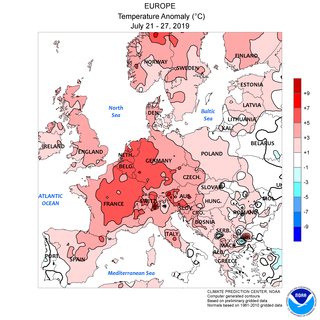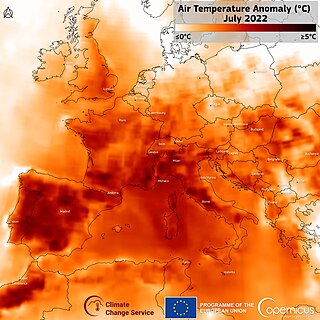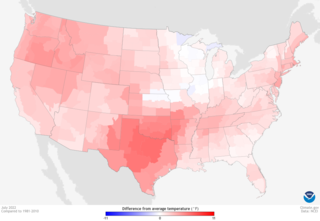Related Research Articles

The 2003 European heat wave saw the hottest summer recorded in Europe since at least 1540. France was hit especially hard. The heat wave led to health crises in several countries and combined with drought to create a crop shortfall in parts of Southern Europe. The death toll has been estimated at more than 70,000.

Adelaide, the capital city of South Australia, has a Mediterranean climate, with mild wet winters and hot dry summers.

Launceston, Tasmania has a cool, temperate climate, with four distinct seasons. The city is located in the Tamar Valley in Northern Tasmania and is surrounded by many large hills and mountains. With this type of topography, Launceston's weather patterns can change considerably in a short period.
The 1906 British Isles heatwave occurred across the British Isles in August and September 1906. The heat wave had a comparable intensity to the 1990 heat wave. From 31 August to 3 September, the temperature in the UK exceeded 32 °C (90 °F) consecutively over much of the UK. In September, Central England and Birmingham recorded a maximum temperature of 31.5 °C (88.7 °F), while Oxford recorded a maximum temperature of 33.1 °C (91.6 °F).

The 2010 Northern Hemisphere summer heat waves included severe heat waves that impacted most of the United States, Kazakhstan, Mongolia, China, Hong Kong, North Africa and the European continent as a whole, along with parts of Canada, Russia, Indochina, South Korea and Japan during July 29, 2010. The first phase of the global heatwaves was caused by a moderate El Niño event, which lasted from June 2009 to May 2010. This lasted only from April 2010 to June 2010 and caused only moderate above-average temperatures in the affected regions, but it also set new record high temperatures for most of the area affected in the Northern Hemisphere.

The 1911 Eastern North America heat wave was an 11-day severe heat wave that killed at least 380 people, though estimates have put the death toll as high as 2,000 people. The heat wave began on July 4, 1911 and didn't cease until July 15. In Nashua, New Hampshire, the temperature peaked at 106 °F (41 °C). In New York City 158 people and 600 horses died.
The 2011 North American heat wave was a deadly summer 2011 heat wave that affected the Southern Plains, the Midwestern United States, Eastern Canada, the Northeastern United States, and much of the Eastern Seaboard, and had Heat index/Humidex readings reaching upwards of 131 °F (55 °C). On a national basis, the heat wave was the hottest in 75 years.

The Summer 2012 North American heat wave was one of the most severe heat waves in modern North American history. It resulted in more than 82 heat-related deaths across the United States and Canada, and an additional twenty-two people died in the resultant June 2012 North American derecho. This long-lived, straight-line wind and its thunderstorms cut electrical power to 3.7 million customers. Over 500,000 were still without power on July 6, as the heat wave continued. Temperatures generally decreased somewhat the week of July 9 in the east, but the high pressure shifted to the west, causing the core of the hot weather to build in the Mountain States and the Southwestern United States shifting eastwards again by mid-July. By early August, the core of the heat remained over the Southern Plains.
The 2013 heatwave in the United Kingdom and Ireland was a period of unusually hot weather primarily in July 2013, with isolated warm days in June and August. A prolonged high pressure system over Great Britain and Ireland caused higher than average temperatures for 19 consecutive days in July, reaching 33.5 °C (92.3 °F) at Heathrow and Northolt.

The 1901 eastern United States heat wave was the most severe and deadly heat wave in the United States prior to the 1930s Dust Bowl. Although the heat wave did not set many still-standing daily temperature records, it was exceptionally prolonged – covering without interruption the second half of June and all of July – and centered upon more highly populated areas than later American heat waves. The heat wave accompanied a major drought in the Ohio Valley and Upper Midwest, with Illinois recording what remains its driest calendar year since records have been kept, and Missouri receiving only 0.21 inches (5.3 mm) above its driest calendar year of 1953.

The 2018 Britain and Ireland heatwave was a period of unusually hot weather that took place in June, July and August. It caused widespread drought, hosepipe bans, crop failures, and a number of wildfires. These wildfires worst affected northern moorland areas around the Greater Manchester region, the largest was at Saddleworth Moor and another was at Winter Hill, together these burned over 14 square miles (36 km2) of land over a period of nearly a month.

In late June and late July 2019 there were two temporally distinct European heat waves, which set all-time high temperature records in Belgium, France, Germany, Luxembourg, the Netherlands, and the United Kingdom.

The 2021 Western North America heat wave was an extreme heat wave that affected much of Western North America from late June through mid-July 2021. The heat wave affected Northern California, Idaho, Western Nevada, Oregon, and Washington in the United States, as well as British Columbia, and in its latter phase, Alberta, Manitoba, the Northwest Territories, Saskatchewan, and Yukon, all in Canada. It also affected inland regions of Central and Southern California, Nevada, and Montana, though the temperature anomalies were not as extreme as in the regions farther north.
The 2021 Britain and Ireland heat wave was a period of unusually hot weather in July 2021 that led to record-breaking temperatures in the UK and Ireland.

In 2022, several areas of the world experienced heat waves. Heat waves were especially notable in East Asia, the Indian subcontinent, Australia, western Europe, the United States, and southern South America. 2022 heat waves accounted for record-breaking temperatures and, in some regions, heat-related deaths. Heat waves were worsened by the effects of climate change, and they exacerbated droughts and wildfires.

The 2022 Japan heatwave was a heatwave that affected many prefectures. Temperatures peaked at 40.2 °C (104.4 °F) in Isesaki, Gunma Prefecture. 15,657 people were taken to hospital emergency departments, 5,261 of whom were admitted.

From June to August 2022, persistent heatwaves affected parts of Europe, causing evacuations and killing tens of thousands. These heat waves were the deadliest meteorological events in 2022. The highest temperature recorded was 47.0 °C (116.6 °F) in Pinhão, Portugal, on 14 July.

From late spring to late summer heat waves in 2022 smashed many records in North America between May and September of that year. Dozens of temperature records were surpassed in the United States.

A number of heat waves began across parts of the northern hemisphere in April 2023, many of which are ongoing. Various heat records have been broken, with July being the hottest month ever recorded.
References
- ↑ George, Thomas (August 2, 2001). "PRO FOOTBALL: Heat Kills a Pro Football Player; N.F.L. Orders a Training Review". The New York Times. Retrieved November 26, 2018.
- ↑ "Deaths of 4 New Yorkers Are Attributed to the Heat". The New York Times. August 13, 2001.
- ↑ "Swath of U.S. Sweats Out Another Heat Wave". The New York Times. August 4, 2001.